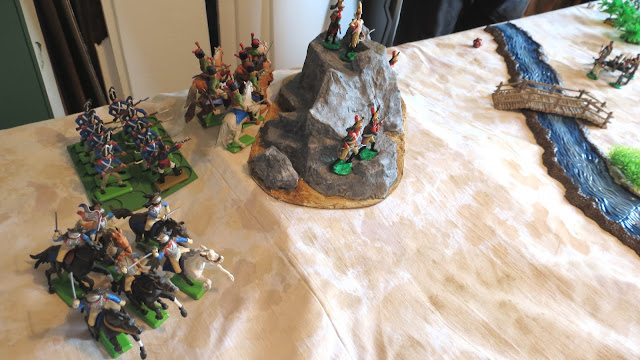As part of Operation Windsor of 4th July 1944 the 8th Canadian Infantry Brigade advanced from the Normandy bridgehead to capture the airfield outside the village of Carpiquet and this is the scenario that Anthony and I chose to play using 54mm toy soldiers and the Memoir 44 game system devised by Richard Borg.
The Canadian armour advances, this game system is very much about the tanks, they have great mobility and firepower but their full potential can only be exercised in open country, their effectiveness is much diminished against troops in cover.
On the German left wing, infantry of both sides move cautiously forward, probing and making maximum use of terrain for cover.
The two panzer units on the German right wing have elite status, which gives them a marginal edge in tank on tank combat, they launched an all out attack and made short work of the opposing Shermans
Infantry have great resilience when in cover, several times the defenders were forced out of their positions but quickly regrouped and returned to the fray.
The Allied armour eventually broke out of the bocage but by then the panzers had command of the open ground and there was nothing for it but to fall back.
The game was fast paced and the outcome played out very similar to the original action in 1944, from that point of view we judged it to have worked well. Visually it was nice to see the Britains Deetail figures on the table and six figure units looked about right but I think we need to work on the representation of built up areas (which I feel is an issue with grid based games) and perhaps some explosive blast markers. It lasted about an hour and a half.
Elsewhere, the latest issue of Plastic Warrior magazine arrived in the post this morning (see PW link in column on the left), the Woking Games Day is being held this Saturday (for details see the Little Wars Revisited link in the column on the left) and we also have the London Toy Soldier Show coming up on the 30th March, so a busy few weeks ahead.
Elsewhere, the latest issue of Plastic Warrior magazine arrived in the post this morning (see PW link in column on the left), the Woking Games Day is being held this Saturday (for details see the Little Wars Revisited link in the column on the left) and we also have the London Toy Soldier Show coming up on the 30th March, so a busy few weeks ahead.


















































